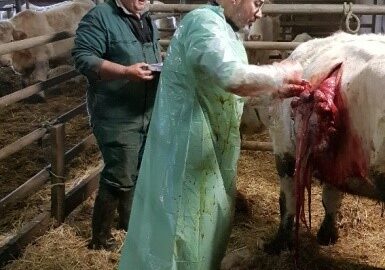Prélèvements en vue d’analyses complémentaires lors d’avortements chez les bovins

Auteurs
Résumé
Le diagnostic de laboratoire lors d’avortements en série chez les bovins requiert des substrats de qualité reflétant le plus fidèlement possible l’environnement du foetus au moment de sa mort in utero : bons échantillons, bonne conservation, non-pollution par les contaminants extérieurs. Un consensus existe sur la nature des prélèvements servant au diagnostic direct (mise en évidence de l’agent en cause) ainsi que sur l’échantillonnage à respecter pour le diagnostic indirect (mise en évidence de la réponse humorale). Des gestes pour la réalisation de prélèvements que le praticien appelé au chevet de la vache avortée n’a pas l’habitude de réaliser sont détaillés, à savoir l’écouvillonnage endocervical et le prélèvement de liquide stomacal de l’avorton. Un rappel des règles à observer pour recueillir du sang des congénères des vaches avortées est proposé. Il permet d’établir un premier diagnostic sérologique de troupeau.
Abstract
Laboratory diagnosis in the case of a series of abortions in cattle requires sampling which reflects as closely as possible the environment of the fœtus at the time of in utero death: good sampling, good conservation and absence of contamination. A consensus exists on the type of sample needed to perform a direct diagnosis (by identifying the causal agent) as well as that for indirect diagnosis (identification of the cow’s humoral response). The things that the practitioner needs to do when called-out to a case of cow abortion, when he has little experience, are described: endocervical smear and sampling of the stomach contents of the aborted foetus. A reminder of the rules which must be observed to collect blood from the conspecifics of cows which have aborted is given. It allows the establishment of an initial serological diagnosis of the herd.
D'autres articles
JNGTV 2007 Page 389
Toutes espèces · Aucun thème
La productivité du travail, les coûts de production et le revenu dans les exploitations laitières spécialisées du nord de l’Union européenne
Découvrez aussi nos formations
05 janvier 2026
5 jours
Bovin laitier · Bovin viande · Bovins


